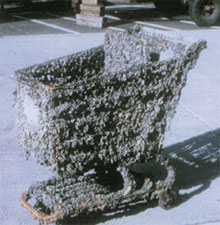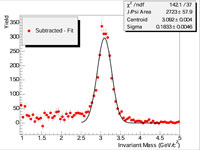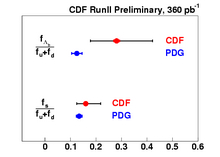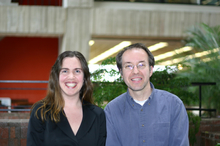 | Thursday, May 4, 2006 |
|
Thursday, May 4 2:00 p.m. Research Techniques Seminar - (Comitium) Speaker: V. Saveliev, DESY/Obninsk University Title: Silicon Photomultipliers: Recent Development and Application 2:30 p.m. Theoretical Physics Seminar - Curia II Speaker: C. Bauer, Lawrence Berkeley National Laboratory Title: Improving Jet Distributions with Effective Field Theory 3:30 p.m. DIRECTOR'S COFFEE BREAK - 2nd Flr X-Over THERE WILL BE NO ACCELERATOR PHYSICS AND TECHNOLOGY SEMINAR TODAY
Friday, May 5 |
|
Extended Forecast |
Secon Level 3 |
|
Friday, May 5 -Minnesota Wild Rice w/Chicken -Tuna Melt on Nine Grain -BBQ Ribs -Sauteed Liver & Onions -Buffalo Chicken Wrap -Assorted Pizza -Mandarin Chicken Salad |
|
Thursday, May 4
Wednesday, May 10
Chez Leon Menu |
| Fermilab Today is online at: http://www.fnal.gov/today/ Send comments and suggestions to today@fnal.gov Fermilab Today archive Hurricane Relief Page Fermilab Today PDF Version Fermilab Result of the Week archive Fermilab Safety Tip of the Week archive Linear Collider News archive Fermilab Today classifieds Subscribe/Unsubscribe to |
|
|||
|
Renowned physicist and author Brian Greene will address the Congressional Research and Development Caucus Advisory Committee from 3:00 to 4:30 p.m. Tuesday, May 9, in the Cannon Caucus Room, 345 Cannon, Washington, D.C. The event is hosted by House Science Committee members Rep. Judy Biggert and Rep. Rush Holt, and is open to interested citizens. Greene’s talk is titled "Reaching for Einstein’s Dream: The Quest for the Deepest Laws of the Universe."
Einstein sought but never found a "unified theory" of the universe: a single, all-encompassing framework for explaining the cosmos. Today, scientists have picked up where Einstein left off and may well be closing in on the universe’s deepest laws. Impressive theoretical developments are much in need of experimental input, providing fertile ground for revolutionary breakthroughs in our understanding of the universe.
|
|
PHENIX Data Fly With GridFTP
| ||
|
The hunt for the quark-gluon plasma, a state of matter that may have existed in the very early universe, is getting a little help from a common grid tool. During the current run of the Relativistic Heavy Ion Collider at Brookhaven National Laboratory, the PHENIX nuclear physics experiment is using GridFTP to transfer data automatically between BNL and Vanderbilt University.
Read More |
|
The Timberjay, May 3, 2006: Tours of MINOS lab at Soudan offered on May 6 They’re really, really tiny, but they do have mass. That’s the word from the MINOS lab at the Soudan Underground Mine State Park, where the public is invited to come for a free tour on Saturday, May 6 from 8:30 a.m. - 4:00 p.m. Tours will start every ten minutes, and are first-come, first-serve.
This will be the 16th year that scientists at the Soudan Underground Mine State Park have opened up their labs to the public, and the tours this year will focus on the first published findings from the MINOS experiment.
|
| At the bottom of everything... | ||
| ||
|
Sometimes, it's good to get to the bottom of everything, especially at
the CDF experiment. A bottom quark produced in a proton-antiproton
collision at the Tevatron cannot exist by itself. In a process called
fragmentation, the energetic bottom quark excites the vacuum, creates
additional quarks, and combines with them to form more stable
two-quark or three-quark states. The rates at which it combines with
an up, down, or strange quark to form a two-quark state--called a
B+, B0, or B0s meson,
respectively--are referred to as b-quark fragmentation fractions. Included in
these fragmentation fractions is also the rate at which a b-quark
combines with a quark pair to form a three-quark state, a bottom
baryon. In Run I of the Tevatron, CDF observed an intriguing
enhancement of B0s meson production compared to
results from the LEP e+e- collider, although the statistical power of
the measurement was limited.
Large samples of semileptonic decays, in which the bottom quark decays
to a charm quark plus a lepton and neutrino, are used to measure the
fragmentation rate of B hadrons. The observed numbers of events with a
lepton and charm combination are attributed to the B meson and baryon
species through a method called sample composition.
CDF now observes the rate into two separate two-quark states, in
particular into B0s mesons, in better accord with
the previous LEP measurements. However, a more interesting development
is found in the fragmentation rate of three-quark states
(Λb baryons), which is now measured almost two
standard deviations higher than previous results of this quantity. As
it turns out, life at the bottom is exciting! | ||
| ||
| Result of the Week Archive
|
|
EPP2010 Committee members to speak at Fermilab May 12 The EPP2010 report made headlines on Thursday. What does it say about the future of Fermilab? Find out more on May 12, when EPP2010 Committee member Chuck Shank and Committee co-chair Sally Dawson come to speak to the Fermilab community. They will discuss the report at a 1:30 p.m. meeting in the Ramsey Auditorium. Everyone at Fermilab is invited to attend.
D Road tentatively scheduled
Batavia Road entrance to close for cars and bicycles
I Solisti della Scala Trio, May 5
Artist Reception |




